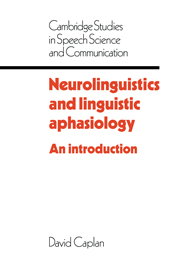Book contents
- Frontmatter
- Contents
- Preface
- Part I Introduction
- 1 Issues in neurolinguistics and linguistic aphasiology
- 2 Approaches to neurolinguistics and linguistic aphasiology
- Part II Clinical aphasiology and neurolinguistics
- Part III Linguistic aphasiology
- Part IV Contemporary neurolinguistics
- References
- Author index
- Subject index
2 - Approaches to neurolinguistics and linguistic aphasiology
Published online by Cambridge University Press: 10 December 2009
- Frontmatter
- Contents
- Preface
- Part I Introduction
- 1 Issues in neurolinguistics and linguistic aphasiology
- 2 Approaches to neurolinguistics and linguistic aphasiology
- Part II Clinical aphasiology and neurolinguistics
- Part III Linguistic aphasiology
- Part IV Contemporary neurolinguistics
- References
- Author index
- Subject index
Summary
As we take up the subject matter of neurolinguistics and linguistic aphasiology in the chapters to follow, we will encounter various ways of gathering evidence and of reasoning about data to draw conclusions about language breakdown and the relationship between language and brain. Before entering into the subject matter itself, it is worthwhile to consider an overview of these methods and forms of argumentation. In this chapter, we shall outline four approaches to reasoning about language–brain relationships, illustrating each with sketches of arguments which have been made by investigators at various times. (We shall consider the actual arguments in greater detail later, in the appropriate chapters.) We then shall review several techniques of study which are used in neurolinguistic research. Finally, we shall consider several issues which arise in the analysis of language disturbances which are central to the work of linguistic aphasiology. With this background, we shall be better equipped to turn to actual studies of language–brain relationships and language breakdown in the body of this volume.
Four forms of argument in neurolinguistics
Arguments from linguistic and psycholinguistic structures to neural structures
One form of argument relating language and the brain looks at features of language structure and the psychology of language use, and argues that these features suggest that the brain is structured and operates in particular ways. Two examples from the classical clinical literature on neurolinguistics will illustrate this type of argument.
Before he turned over his creative genius to psychoanalysis, Sigmund Freud wrote a short monograph on aphasia (1891).
- Type
- Chapter
- Information
- Neurolinguistics and Linguistic AphasiologyAn Introduction, pp. 17 - 40Publisher: Cambridge University PressPrint publication year: 1987

